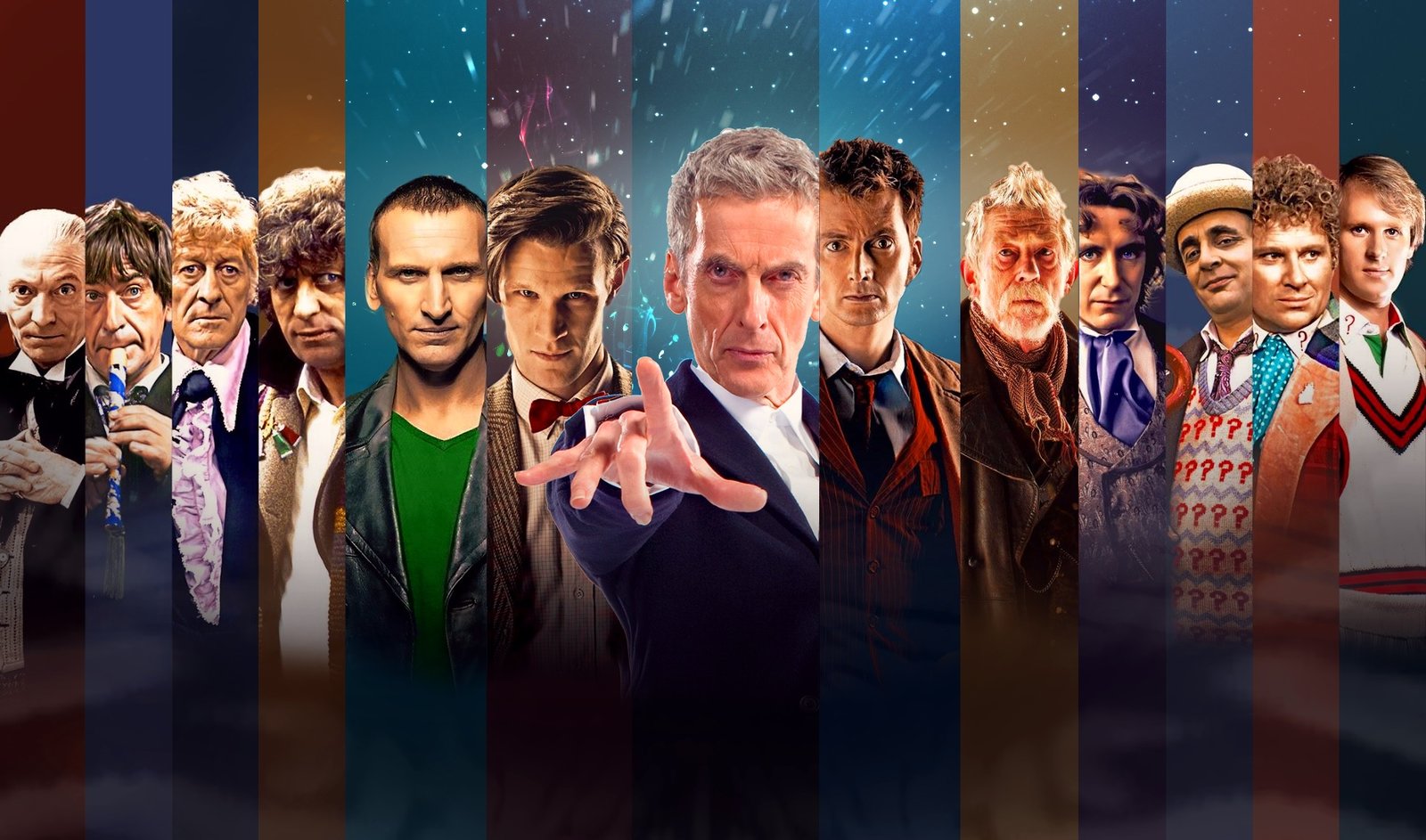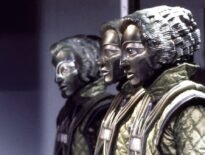We’re currently awaiting confirmations and announcements regarding “The Whoniverse”. This is Russell T Davies’ master plan to create a new collection of TV shows — and beyond — emanating from the world of Doctor Who. This is not a new concept. Building and expanding fictional universes in television and film has been a thing for nearly 100 years.
To get a better idea what Russell’s up against, let’s take a look at shared universes in the visual media.
Over here in the states, spin-offs of TV shows are certainly nothing new. Back in the 1970s, we were insane with spin-offs. All in the Family begat The Jeffersons and Maude, which begat Good Times. Mary Tyler Moore begat Rhoda, Phyllis, and Lou Grant. These are just a few examples out of hundreds. It happened a lot — such was the strength of the primary shows and the strength of the side characters who got their own spin-offs. The stronger the character and creative team behind them, the better the results. And while we remember the successful spin-offs, like Frasier coming off Cheers, many others, like Joey after Friends… not so much. Far more misses than hits.
In cinema, it’s been a strikingly different situation. To successfully create one successful film is almost an anomaly, because so many things have to go just right. You need the right actors, script, director, director of photography, musical score, and producers that help, not hinder. Oh, and MONEY. It is extremely difficult to make a hit film. To create an interconnected cinematic universe is a Herculean feat, and for it to be successful? The nearly impossible task becomes exponentially more difficult.
Universal films had the only successful cinematic universe for a generation during the ‘30s, ‘40s, and into the ‘50s, and that was thanks to the Universal Monsters. Dracula, Frankenstein’s monster, the Werewolf, the Mummy, the Creature from the Black Lagoon, and all the various brides, sons, and Abbot & Costello collected together where cinematic crossovers and spin-offs were king. Larger than life characters all inhabiting their own films in one, interconnected universe.
Sadly, Universal couldn’t follow it up successfully 70 years later, when trying to do it again. They had Tom Cruise in The Mummy, introducing Russell Crowe as Dr. Jekyll/Mr. Hyde, but it under performed, and that was it for the “Dark Universe”.
The Godzilla franchise started out strong in the ‘50s, and although things got silly at points during the ’60s and ‘70s, it was another popular franchise, again monster-driven, and interconnected, if not always critically acclaimed. Legendary films has recently re-ignited the kaiju craze with a new interconnected universe featuring Godzilla and King Kong, which has gone over well with the viewing public.

Star Wars, having embarked on their third trilogy, decided to expand their universe with a flashback film called Rogue One, with more projects in the works as well. You could ask: why did the powers that be suddenly start thinking bigger and wider when it comes to the Force? Or why did Universal try to jump start their half century old interconnected universe again? Or why did the Godzilla franchise once again open up shop with Kong? Well yes, Hollywood has shown us that no franchise can ever be allowed to die, or completely fade away. And of course, money is a thing. Even Freddy and Jason had a crossover, and Predator and Aliens have crossed over, and they were variously successful stunts… but…
Kevin Fiege showed everyone how to construct a quality, interconnected cinematic universe, how to do it well, and how to do it BIG. The Marvel Cinematic Universe is the most successful franchise in movie history by a country mile. Starting with Iron Man in 2008, the MCU has produced around 30 films, bringing the characters from their comics alive on the screen. It has been the monumental achievement in cinema. And here’s the kicker. When they started the thing, they didn’t even have any of their most popular characters to work with.
No, the X-Men, Spider-Man, and the Fantastic Four’s rights were tied up with other studios. So Fiege and Marvel rolled the dice, started their own studio, took a bunch of their second- and third-tier characters, and made it happen. One big advantage Fiege had was that Marvel comics was one big shared, interconnected universe starting all the way back in the ‘60s (or arguably from Marvel Comics #1 in 1939) when Stan Lee set the stories all in New York City, where all the heroes interacted with each other in all the books.
So the suits involved with Universal, Godzilla, Star Wars, all took note and dove in — to various degrees of success and failure. Sony, who still has the rights to Spider-Man, eventually played it smart after their Spider-Man efforts continued to sink, and partnered with Marvel to share Peter Parker et al., bringing him into the MCU. More on them later.
And then streaming happened. And Disney happened. Having purchased Marvel and Star Wars, they created the online Disney + streaming service. Suddenly, cinema and TV meshed together in streaming, and the franchises gathered together. Disney wisely let the franchises do their own thing, again, to varying degrees of success. Marvel has its films and streaming series; Star Wars has its streaming series and will venture back into the theatre in future.
And here, now, is where Doctor Who enters the big picture on Disney +, under the stewardship and creative control of Russell T Davies.
Now, Marvel has the streaming series, which spun out of the films, which spun out of their comics. Star Wars has their streaming series, various animated series, and comics which spun from the films. Doctor Who has comics and audios that spun from their television series — which will soon also be a streaming series.

So we’re dealing with three different franchises, all coming from different media, to land in the same place.
At this point, we have to look at the potential for stories, characters, possibilities. How strong are the rosters for each franchise, that they can build more sub franchises and spin-offs? Marvel. Star Wars. Doctor Who.
Hands down, Marvel wins this competition with about 1,000 characters in their pockets, and creative direction that’s taken even bottom of the barrel, fourth tier characters like the Guardians of the Galaxy and turned them into superstars. The sub franchises are lining up around the block. Even though they’ve taken a couple critical blows in Phase 4, they’re still sitting pretty, as long as they can keep bringing in new, quality creatives for these projects, as they’ve got tons of raw material to work with.
In fact, Marvel’s comic universes boasts some 70,000 characters.
Their big competition, DC, has mostly been an uncoordinated mess with their cinematic universe, but they’re poised to turn things around moving forward with James Gunn, with their less populated but still formidable roster of characters to work with.
Star Wars has plenty of popular characters, but the majority of them are generations old, as are the actors who portrayed them. They’d have to bring in more new characters to breathe more life into the universe. The Mandalorian had a good start in that direction, while Andor has been critically acclaimed, but it may not be enough. The most recent films and several of the streaming series have taken a lot of critical blows, and yet they also have plenty to work with to right the ship.
To contrast all those crowded universes, Doctor Who has… well, the Doctor. And all of time and space. It’s simultaneously very little, yet everything.
The American counterpoint to Who would be Star Trek. Another TV series that was very popular in the 1960s, went away, had some wilderness years, came back, transformed itself, travelled across centuries, and gave us some incredible performances, by several different ensembles, with numerous ships, captains and crews, over six decades. The big difference would be the 13 feature films, but in the end, they also ended up streaming new series, to varying degrees of success. But they’ve got more stories to tell, if, like Star Wars, they can bring in more, better talent to maintain their universe and bring it forward in the years to come.
Which brings us back to Doctor Who. Aside from the Peter Cushing films, which aren’t even canon, we’ve got a few anniversary events, two or three old spin-offs, a TV movie, and that’s about it. Marvel can lean on its library of hundreds of thousands of comics and characters. Star Wars can mine every last character from their films and even their animated series. Who has to rely on the main TV show, and the characters that have come to life through it over the past 60 years.
The big question is, does Doctor Who have the necessary raw material aside from the Doctor to successfully populate a Whoniverse?

With Who, more than any other franchise, everything depends on the creatives. Whereas Marvel’s strengths lie in their comics’ human characters with feet of clay, and Star Wars survived on eye popping effects in their films, both parlaying their empires into juggernauts, Doctor Who had humbler beginnings. No SFX, no budget, not even in colour for the first six years… yet winning the hearts of their fans with a handful of amazing actors working in conjunction with brilliant stories, and an incredible array of monsters and villains.
After a while, people get jaded and tired of SFX, and not all comic characters are going to charm and excite people. But Doctor Who comes from a different place. Many of us fell in love with it when it had no money, just a wonderful personality. It’s our best friend, as well as our love. This counts for something. So when we assess what will come with this new “Whoniverse”, that will be one advantage. Another would be Russell.
Another comparison. Sony has the film rights to Spider-Man, and the entire Spider-Man comic world. While the MCU has made the Tom Holland films wildly popular, Sony has had to make their own movies with other, lesser-known Spider-Man properties. Venom. Morbius. Kraven the Hunter. Madame Webb. Rocket Racer. Venom was a big hit at the box office; Morbius was not. No idea how the rest will fare. Sony is basically rolling the dice here, doing films featuring Spider-Man’s villains, trying to turn them into anti-heroes, and it’s a very dicey plan.
But it’s all they’ve got. They do have the Spider-Verse and Miles Morales in animated form, but on the whole, Sony’s very limited as to what they’ve got to work with as far as bankable franchises. This is no doubt partially the reason they bought Bad Wolf. Sony’s wonderful working relationship with Marvel/Disney has been a win/win for them, and their respective shareholders. Now, Sony has a piece of another legendary franchise in Doctor Who.
The difference between the limited amount of raw materials on hand for Sony in regards to Spider-Man’s rogue’s gallery, and what’s available in the world of Who is down to who’s in charge of creative. Sony doesn’t really have a dedicated Kevin Fiege or a set up like the MCU for their Spidey division. But for Who, they do have RTD with Bad Wolf. This makes all the difference in the world, and it gives us hope.
So over the next several months, we’re going to hear a lot about the coming Whoniverse. Some of the ideas may seem exciting, or daft, or rubbish, but it doesn’t really matter as long as the plan is strong. As long as the writing and the creative vision are strong. Yes, our love has got some more money now, but that won’t matter, as long as that personality is still going strong.
I suppose that we can see the potential for the wider world of Who, spin-offs, and RTD’s approach by looking back to the Doctor-lite stories, such as Blink and Turn Left, where we look into the world beyond the Doctor. There are clearly stories that can be told outside of the Doctor.
In Russell we trust. He has quite a bit of work to do.



